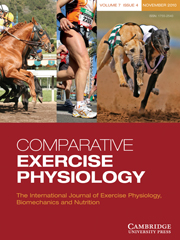Article contents
Protein carbonyl assay to measure oxidative stress in muscle of exercising horses supplemented with vitamin E
Published online by Cambridge University Press: 02 June 2009
Abstract
Intense exercise has been associated with free radical damage that forms potentially measurable by-products in the blood and muscle of exercising subjects. The extent of damage to the exercising animal has yet to be conclusively determined, and studies often focus on by-products in the blood rather than muscle. The current study examined the presence of oxidative products in the muscle of exercising horses as well as the effects of excess vitamin E on the presence of these products. Eight Thoroughbred horses were used in a crossover design, with one group being fed vitamin E at the 1989 NRC [National Research Council (1989) Nutrient Requirements of Horses. 5th revised edn.; Washington DC: National Academy Press, pp. 48] level recommended for horses in moderate to intense work (80 IU kg DM− 1), and the second group being fed the control diet plus 3000 IU day− 1dl-α-tocopheryl acetate. The horses underwent an 8-week training programme and a final standard exercise test (SET). During the SET, the horses ran on a 6° incline to exhaustion. Muscle samples were biopsied before and after performing the SET and analysed for the presence of carbonyl groups and ubiquitin. Blood was collected prior to the SET and analysed for vitamin E. No significant differences in plasma vitamin E were found between treatment groups. However, myofibril carbonylation, a product of free radical damage to muscle tissue, was found to be lower in vitamin E-supplemented horses post-SET exercise (P < 0.05), suggesting that vitamin E influences some measures of oxidative stress in exercising horses, particularly following a strenuous bout of exercise. Ubiquitin was not detected in myofibrils, indicating clearance of carbonyl groups by a different mechanism.
- Type
- Short Communication
- Information
- Copyright
- Copyright © Cambridge University Press 2009
Footnotes
Present address: Edgar Rhodes Center For ADS, University of Georgia, 425 River Road, Athens, GA 30 602, USA
References
- 3
- Cited by


